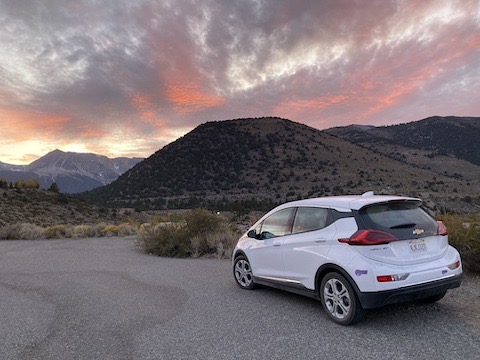
Just under a year ago (March 2019), I did something wildly uncharacteristic and bought my first new vehicle. I’d been daydreaming about an EV for some time to use for commuting and local trips, and the combination of the growing ubiquity of Tesla’s Model 3 in the bay area and the expiration of the the $7,500 EV Federal Rebate finally spurred me to action. Fast-forward a few weeks and after finding the leasing terms not that great, for roughly the same cost as a Honda Civic after rebates, I found myself the proud owner of a white 2019 Chevy Bolt (with fast charging option).
I was initially a bit apprehensive that coming from a Honda Civic del Sol with it’s low seating position, excellent handling and delightful 5 speed manual transmission, the tall, heavy, fully-automatic Bolt would prove a dull driving companion. Happily that has not proven the case. While tall, the Bolt has a fairly low center of gravity and despite tires that are somewhat deficient on grip, it maneuvers adeptly at low and medium speeds. And of course the Bolt has something the Honda did not – instant acceleration with no noise or fuss. Many is the time that I’ve zipped past an overbearing pickup or muscle car at an intersection.
The Bolt is also wonderfully quiet. In my Honda I had basically given up listening to classical music because except at very low speeds, road noise or engine noise would overwhelm the quiet parts of the music. Heck – at 70MPH even a conversation required raising my voice considerably. The Bolt’s motor by contrast provides just the faintest whir as it propels you forward. Road noise is also pretty good, though pavement quality can make a big difference one way or the other. Given the crowded, noisy nature of the roads during commute times, the quieter drive makes the experience a lot less unpleasant.
While the Bolt’s appearance is a bit polarizing (I’m in the camp that wished it looked more like a VW Golf and less like an SUV), the interior is eminently practical. Foot and headspace is better than my old 5-series BMW and while the hatch is not large, it can certainly accommodate a weekend’s camping equipment. For larger items, the rear seats fold nearly flat. In fact I can actually spread my sleeping bag out and lie all the way down, if the front seats are pushed forward. The 10-inch LCD in the center console is nothing fancy, but it works well for Google Maps via Apple CarPlay (much better than mounting my phone in the fan vent, as I did in my old car).
Of course the Bolt isn’t just another fun, modern hatchback – it’s also an EV. For local driving this requires very little adjustment. As long as you have access to a charger at work or at home, you simply need to be diligent about plugging it in regularly. These types of chargers are not fast – they tend to add range at a rate of 25 miles per hour plugged in – but for anything under 200 miles in a day – there’s not much to it. Even at PG&E’s inflated electric rates, if you’re charging at under $0.25/kWh, you’re paying less in electricity than your average Prius driver pays for gasoline.
Longer trips with the Bolt are where things get a little more complicated. To avoid 8-10 hour recharge times, the Bolt also supports DC Fast Charging (it’s a $750 option) which will usually get you from 0-50% in about half an hour, and from 0-80% in just over an hour (there are a few factors that affect DCFC speed). The main caveat is the DCFCs are not yet ubiquitous – some areas have many at regular intervals, others have none, and unfortunately a decent number are for one reason or another unreliable. The upshot is you need to plan trips more carefully (the plugshare website is invaluable for this), set aside some extra time for charging, and be prepared to adjust your itinerary based on the availability of charging stations. When I got the Bolt, I assumed long-distance trips were simply infeasible and that I would use my other non-EV car. In practice, it’s proven quite doable and I’ve actually come to enjoy the small extra challenge when planning trips. So far the Bolt and I have done a fair number of trips, including from San Jose to Los Angeles (400 miles in a day), Crescent City to San Jose (350 miles in a day) and Mammoth Lakes to San Jose (300 miles in a day).
Finally, a small note about efficiency and range anxiety. One big difference between EVs and gasoline vehicles is the variability of energy consumption. EVs are signficantly more sensitive to changes in speed, terrain, temperature and use of heating/AC. As a quick example, going from 55mph to 70mph on a flat road tends to drop my efficiency by about 30%. Thus it is somewhat harder to predict how much ‘range’ one has. For local trips and commuting, this basically doesn’t matter because one is never far from a charging station. But for longer trips, it can be trickier. I certainly wouldn’t say range anxiety is a big part of EV ownership, but it is occasionally something one must contend with (that said, I have also almost run out of gas on several occasions).
So after a year with the Bolt, my main regret is that I didn’t get one sooner. It’s a clean, quiet, fun vehicle that covers almost all of my needs quite well. Even it’s one limitation, long road trips, have proven a lot less significant than I expected. It doesn’t hurt that I’ve covered more than 23,000 miles, spending only around one fifth as much on charging as I would have on gasoline for the old car. I’m looking forward to many more EV traveling adventures in the years to come.
